[English] 日本語
 Yorodumi
Yorodumi- PDB-4g21: Structural basis for the accommodation of bis- and tris-aromatic ... -
+ Open data
Open data
- Basic information
Basic information
| Entry | Database: PDB / ID: 4g21 | ||||||
|---|---|---|---|---|---|---|---|
| Title | Structural basis for the accommodation of bis- and tris-aromatic derivatives in Vitamin D Nuclear Receptor | ||||||
 Components Components |
| ||||||
 Keywords Keywords | transcription/transcription inhibitor / VDR /  transcription regulation / transcription regulation /  nuclear receptor / alpha helical sandwich / nuclear receptor / alpha helical sandwich /  ligand / ligand /  DNA / DNA /  phosphorylation / phosphorylation /  nucleus / transcription-transcription inhibitor complex nucleus / transcription-transcription inhibitor complex | ||||||
| Function / homology |  Function and homology information Function and homology informationheart jogging / Vitamin D (calciferol) metabolism / : / SUMOylation of intracellular receptors /  vitamin D binding / vitamin D binding /  calcitriol binding / calcitriol binding /  lithocholic acid binding / labyrinthine layer morphogenesis / regulation of thyroid hormone mediated signaling pathway / positive regulation of transcription from RNA polymerase II promoter by galactose ...heart jogging / Vitamin D (calciferol) metabolism / : / SUMOylation of intracellular receptors / lithocholic acid binding / labyrinthine layer morphogenesis / regulation of thyroid hormone mediated signaling pathway / positive regulation of transcription from RNA polymerase II promoter by galactose ...heart jogging / Vitamin D (calciferol) metabolism / : / SUMOylation of intracellular receptors /  vitamin D binding / vitamin D binding /  calcitriol binding / calcitriol binding /  lithocholic acid binding / labyrinthine layer morphogenesis / regulation of thyroid hormone mediated signaling pathway / positive regulation of transcription from RNA polymerase II promoter by galactose / positive regulation of female receptivity / hematopoietic stem cell proliferation / hypothalamus development / male mating behavior / NR1H2 & NR1H3 regulate gene expression to control bile acid homeostasis / heart looping / lithocholic acid binding / labyrinthine layer morphogenesis / regulation of thyroid hormone mediated signaling pathway / positive regulation of transcription from RNA polymerase II promoter by galactose / positive regulation of female receptivity / hematopoietic stem cell proliferation / hypothalamus development / male mating behavior / NR1H2 & NR1H3 regulate gene expression to control bile acid homeostasis / heart looping /  estrous cycle / cellular response to Thyroglobulin triiodothyronine / Synthesis of bile acids and bile salts / calcium ion homeostasis / Endogenous sterols / Synthesis of bile acids and bile salts via 27-hydroxycholesterol / Synthesis of bile acids and bile salts via 7alpha-hydroxycholesterol / nuclear retinoid X receptor binding / response to retinoic acid / estrous cycle / cellular response to Thyroglobulin triiodothyronine / Synthesis of bile acids and bile salts / calcium ion homeostasis / Endogenous sterols / Synthesis of bile acids and bile salts via 27-hydroxycholesterol / Synthesis of bile acids and bile salts via 7alpha-hydroxycholesterol / nuclear retinoid X receptor binding / response to retinoic acid /  histone acetyltransferase activity / regulation of cellular response to insulin stimulus / Recycling of bile acids and salts / histone acetyltransferase activity / regulation of cellular response to insulin stimulus / Recycling of bile acids and salts /  histone acetyltransferase / cellular response to hormone stimulus / NR1H3 & NR1H2 regulate gene expression linked to cholesterol transport and efflux / positive regulation of adipose tissue development / peroxisome proliferator activated receptor signaling pathway / RORA activates gene expression / histone acetyltransferase / cellular response to hormone stimulus / NR1H3 & NR1H2 regulate gene expression linked to cholesterol transport and efflux / positive regulation of adipose tissue development / peroxisome proliferator activated receptor signaling pathway / RORA activates gene expression /  lactation / positive regulation of neuron differentiation / Regulation of lipid metabolism by PPARalpha / cerebellum development / lactation / positive regulation of neuron differentiation / Regulation of lipid metabolism by PPARalpha / cerebellum development /  ossification / BMAL1:CLOCK,NPAS2 activates circadian gene expression / SUMOylation of transcription cofactors / Activation of gene expression by SREBF (SREBP) / nuclear receptor coactivator activity / response to progesterone / nuclear estrogen receptor binding / ossification / BMAL1:CLOCK,NPAS2 activates circadian gene expression / SUMOylation of transcription cofactors / Activation of gene expression by SREBF (SREBP) / nuclear receptor coactivator activity / response to progesterone / nuclear estrogen receptor binding /  nuclear receptor binding / hippocampus development / RNA polymerase II transcription regulatory region sequence-specific DNA binding / Heme signaling / mRNA transcription by RNA polymerase II / Transcriptional activation of mitochondrial biogenesis / PPARA activates gene expression / Cytoprotection by HMOX1 / cerebral cortex development / Transcriptional regulation of white adipocyte differentiation / RNA polymerase II transcription regulator complex / male gonad development / nuclear receptor binding / hippocampus development / RNA polymerase II transcription regulatory region sequence-specific DNA binding / Heme signaling / mRNA transcription by RNA polymerase II / Transcriptional activation of mitochondrial biogenesis / PPARA activates gene expression / Cytoprotection by HMOX1 / cerebral cortex development / Transcriptional regulation of white adipocyte differentiation / RNA polymerase II transcription regulator complex / male gonad development /  nuclear receptor activity / nuclear receptor activity /  Circadian Clock / response to estradiol / HATs acetylate histones / Estrogen-dependent gene expression / Circadian Clock / response to estradiol / HATs acetylate histones / Estrogen-dependent gene expression /  transcription regulator complex / transcription regulator complex /  cell differentiation / cell differentiation /  transcription coactivator activity / transcription coactivator activity /  protein dimerization activity / positive regulation of apoptotic process / RNA polymerase II cis-regulatory region sequence-specific DNA binding / DNA-templated transcription / protein dimerization activity / positive regulation of apoptotic process / RNA polymerase II cis-regulatory region sequence-specific DNA binding / DNA-templated transcription /  chromatin binding / chromatin binding /  chromatin / regulation of DNA-templated transcription / positive regulation of DNA-templated transcription / negative regulation of transcription by RNA polymerase II / positive regulation of transcription by RNA polymerase II / protein-containing complex / zinc ion binding / chromatin / regulation of DNA-templated transcription / positive regulation of DNA-templated transcription / negative regulation of transcription by RNA polymerase II / positive regulation of transcription by RNA polymerase II / protein-containing complex / zinc ion binding /  nucleoplasm / nucleoplasm /  nucleus / nucleus /  plasma membrane / plasma membrane /  cytosol / cytosol /  cytoplasm cytoplasmSimilarity search - Function | ||||||
| Biological species |   Danio rerio (zebrafish) Danio rerio (zebrafish)  Homo sapiens (human) Homo sapiens (human) | ||||||
| Method |  X-RAY DIFFRACTION / X-RAY DIFFRACTION /  SYNCHROTRON / SYNCHROTRON /  MOLECULAR REPLACEMENT / Resolution: 2.9 Å MOLECULAR REPLACEMENT / Resolution: 2.9 Å | ||||||
 Authors Authors | Ciesielski, F. / Sato, Y. / Moras, D. / Rochel, N. | ||||||
 Citation Citation |  Journal: J.Med.Chem. / Year: 2012 Journal: J.Med.Chem. / Year: 2012Title: Structural basis for the accommodation of bis- and tris-aromatic derivatives in vitamin d nuclear receptor. Authors: Ciesielski, F. / Sato, Y. / Chebaro, Y. / Moras, D. / Dejaegere, A. / Rochel, N. | ||||||
| History |
|
- Structure visualization
Structure visualization
| Structure viewer | Molecule:  Molmil Molmil Jmol/JSmol Jmol/JSmol |
|---|
- Downloads & links
Downloads & links
- Download
Download
| PDBx/mmCIF format |  4g21.cif.gz 4g21.cif.gz | 65.1 KB | Display |  PDBx/mmCIF format PDBx/mmCIF format |
|---|---|---|---|---|
| PDB format |  pdb4g21.ent.gz pdb4g21.ent.gz | 46.5 KB | Display |  PDB format PDB format |
| PDBx/mmJSON format |  4g21.json.gz 4g21.json.gz | Tree view |  PDBx/mmJSON format PDBx/mmJSON format | |
| Others |  Other downloads Other downloads |
-Validation report
| Arichive directory |  https://data.pdbj.org/pub/pdb/validation_reports/g2/4g21 https://data.pdbj.org/pub/pdb/validation_reports/g2/4g21 ftp://data.pdbj.org/pub/pdb/validation_reports/g2/4g21 ftp://data.pdbj.org/pub/pdb/validation_reports/g2/4g21 | HTTPS FTP |
|---|
-Related structure data
| Related structure data |  4g1dC  4g1yC  4g1zC  4g20C 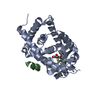 4g2hC  4g2iC C: citing same article ( |
|---|---|
| Similar structure data |
- Links
Links
- Assembly
Assembly
| Deposited unit | 
| ||||||||
|---|---|---|---|---|---|---|---|---|---|
| 1 | 
| ||||||||
| Unit cell |
|
- Components
Components
| #1: Protein | Mass: 33916.543 Da / Num. of mol.: 1 / Fragment: unp residues 156-453 Source method: isolated from a genetically manipulated source Source: (gene. exp.)   Danio rerio (zebrafish) / Gene: vdra, nr1i1a, vdr / Plasmid: pET28 / Production host: Danio rerio (zebrafish) / Gene: vdra, nr1i1a, vdr / Plasmid: pET28 / Production host:   Escherichia coli (E. coli) / Strain (production host): BL21DE3 / References: UniProt: Q9PTN2 Escherichia coli (E. coli) / Strain (production host): BL21DE3 / References: UniProt: Q9PTN2 |
|---|---|
| #2: Protein/peptide |  / NCoA-1 / Class E basic helix-loop-helix protein 74 / bHLHe74 / Protein Hin-2 / RIP160 / Renal ...NCoA-1 / Class E basic helix-loop-helix protein 74 / bHLHe74 / Protein Hin-2 / RIP160 / Renal carcinoma antigen NY-REN-52 / Steroid receptor coactivator 1 / SRC-1 / NCoA-1 / Class E basic helix-loop-helix protein 74 / bHLHe74 / Protein Hin-2 / RIP160 / Renal ...NCoA-1 / Class E basic helix-loop-helix protein 74 / bHLHe74 / Protein Hin-2 / RIP160 / Renal carcinoma antigen NY-REN-52 / Steroid receptor coactivator 1 / SRC-1Mass: 1776.072 Da / Num. of mol.: 1 / Fragment: unp residues 686-700 / Source method: obtained synthetically / Source: (synth.)   Homo sapiens (human) / References: UniProt: Q15788, Homo sapiens (human) / References: UniProt: Q15788,  histone acetyltransferase histone acetyltransferase |
| #3: Chemical | ChemComp-0VP / |
| #4: Water | ChemComp-HOH /  Water Water |
-Experimental details
-Experiment
| Experiment | Method:  X-RAY DIFFRACTION / Number of used crystals: 1 X-RAY DIFFRACTION / Number of used crystals: 1 |
|---|
- Sample preparation
Sample preparation
| Crystal | Density Matthews: 2.34 Å3/Da / Density % sol: 47.49 % |
|---|---|
Crystal grow | Temperature: 295 K / Method: vapor diffusion, hanging drop / pH: 6.5 Details: Bis-Tris 0.1 M, lithium sulfate 1.6 M and magnesium sulfate 50 mM , pH 6.5, VAPOR DIFFUSION, HANGING DROP, temperature 295K |
-Data collection
| Diffraction | Mean temperature: 100 K |
|---|---|
| Diffraction source | Source:  SYNCHROTRON / Site: SYNCHROTRON / Site:  ESRF ESRF  / Beamline: ID14-2 / Beamline: ID14-2 |
| Detector | Type: ADSC QUANTUM 4r / Detector: CCD / Date: 2003 |
| Radiation | Protocol: SINGLE WAVELENGTH / Monochromatic (M) / Laue (L): M / Scattering type: x-ray |
| Radiation wavelength | Relative weight: 1 |
| Reflection | Resolution: 2.9→20 Å / Num. all: 7344 / Num. obs: 7772 / % possible obs: 98 % / Observed criterion σ(F): 2 / Observed criterion σ(I): 2 |
| Reflection shell | Resolution: 2.9→2.97 Å / % possible all: 96.1 |
- Processing
Processing
| Software |
| ||||||||||||||||||||||||||||||||||||||||||||||||||||||||||||
|---|---|---|---|---|---|---|---|---|---|---|---|---|---|---|---|---|---|---|---|---|---|---|---|---|---|---|---|---|---|---|---|---|---|---|---|---|---|---|---|---|---|---|---|---|---|---|---|---|---|---|---|---|---|---|---|---|---|---|---|---|---|
| Refinement | Method to determine structure : :  MOLECULAR REPLACEMENT / Resolution: 2.9→20 Å / σ(F): 0 / Stereochemistry target values: Engh & Huber MOLECULAR REPLACEMENT / Resolution: 2.9→20 Å / σ(F): 0 / Stereochemistry target values: Engh & Huber
| ||||||||||||||||||||||||||||||||||||||||||||||||||||||||||||
| Refinement step | Cycle: LAST / Resolution: 2.9→20 Å
| ||||||||||||||||||||||||||||||||||||||||||||||||||||||||||||
| Refine LS restraints |
|
 Movie
Movie Controller
Controller





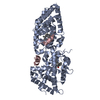


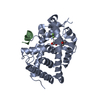

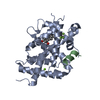
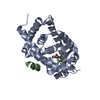

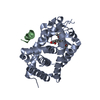

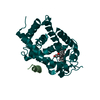


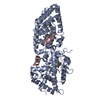


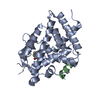
 PDBj
PDBj
















